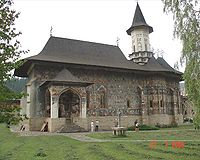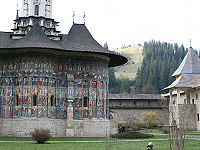
Sucevita Monastery
Encyclopedia


Romania
Romania is a country located at the crossroads of Central and Southeastern Europe, on the Lower Danube, within and outside the Carpathian arch, bordering on the Black Sea...
. It is situated near the Suceviţa River
Sucevita River
The Sucevița River is a tributary of the Suceava River in Romania.-References:* Administrația Națională a Apelor Române - Cadastrul Apelor - București* Institutul de Meteorologie şi Hidrologie - Rîurile României - București 1971...
, in the village Sucevița
Sucevita
Sucevița is a commune in Suceava County, Romania. It is composed of two villages, Sucevița and Voievodeasa.Sucevița Monastery is located in the commune....
, 18 km away from the city of Rădăuţi
Radauti
Rădăuţi is a municipality in Suceava County, Romania with a population of 27,759 inhabitants.-Geography and demographics:Rădăuţi is situated in Bucovina, northern Moldavia, on a plain between the Suceava and Suceviţa rivers, north from Suceava, at 375 m altitude...
, Suceava County
Suceava County
Suceava is a county of Romania, in the historical region of Moldavia and few villages in Transylvania, with the capital city at Suceava.- Demographics :...
. It is located in the southern part of the historical region of Bukovina
Bukovina
Bukovina is a historical region on the northern slopes of the northeastern Carpathian Mountains and the adjoining plains.-Name:The name Bukovina came into official use in 1775 with the region's annexation from the Principality of Moldavia to the possessions of the Habsburg Monarchy, which became...
. It was built in 1585 by Ieremia Movilă
Ieremia Movila
Ieremia Movilă was a Hospodar of Moldavia between August 1595 and May 1600, and again between September 1600 and July 10, 1606.-Rule:...
, Gheorghe Movilă and Simion Movilă
Simion Movila
Simion Movilă, a boyar of the Movileşti family, was twice Prince of Wallachia and Prince of Moldavia on one occasion ....
.
The architecture ot the church contains both Byzantine
Byzantine architecture
Byzantine architecture is the architecture of the Byzantine Empire. The empire gradually emerged as a distinct artistic and cultural entity from what is today referred to as the Roman Empire after AD 330, when the Roman Emperor Constantine moved the capital of the Roman Empire east from Rome to...
and gothic
Gothic architecture
Gothic architecture is a style of architecture that flourished during the high and late medieval period. It evolved from Romanesque architecture and was succeeded by Renaissance architecture....
elements, and some elements typical to other painted churches of northern Moldavia
Painted churches of northern Moldavia
The Churches of Moldavia are eight Romanian Orthodox churches in Suceava County, Romania in northern Moldavia, built approximately between 1487 and 1583.Since 1993, they have been listed by UNESCO as a World Heritage Site...
. Both interior and exterior walls are covered by mural paintings, which are of great artistic value and depict biblical episodes from the Old
Old Testament
The Old Testament, of which Christians hold different views, is a Christian term for the religious writings of ancient Israel held sacred and inspired by Christians which overlaps with the 24-book canon of the Masoretic Text of Judaism...
and New Testament
New Testament
The New Testament is the second major division of the Christian biblical canon, the first such division being the much longer Old Testament....
. The paintings date from around 1601, which makes Suceviţa one of the last monasteries to be decorated in the famous Moldavian style of exterior paintings.
The interior court of the monastic ensemble is almost square (100 by 104 meters) and is surrounded by high (6 m), wide (3 m) walls. There are several other defensive structures within the ensemble, including four towers (one in each corner). Sucevița was a princely residence as well as a fortified monastery. The thick walls today shelter a museum that presents an outstanding collection of historical and art objects. The tomb covers of Ieremia and Simion Movilă – rich portraits embroidered in silver thread – together with ecclesiastical silverware, books and illuminated manuscripts, offer eloquent testimony to Sucevița's importance first as a manuscript workshop, then as a printing center.
In 2010, the monastery has been inscribed by UNESCO
UNESCO
The United Nations Educational, Scientific and Cultural Organization is a specialized agency of the United Nations...
on its list of World Heritage Sites.
See also
- Alexander the Good
- ArboreArboreArbore is a commune located in Suceava County, Romania. It is composed of three villages: Arbore, Bodnăreni and Clit.-Church of Arbore:Arbore is best known for its church, dedicated to Saint John the Baptist. Its painted church was the first Moldavian painted church to be included on the UNESCO...
- Humor MonasteryHumor MonasteryHumor Monastery located in Mănăstirea Humorului, about 5 km north of the town of Gura Humorului, Romania. It is a monastery for nuns dedicated to the Dormition of Virgin Mary, or Theotokos. It was constructed in 1530 by Voievod Petru Rareş and his chancellor Teodor Bubuiog. The monastery was built...
- Moldoviţa Monastery
- Voroneţ MonasteryVoronet MonasteryVoroneț is a monastery in Romania, located in the town of Gura Humorului, Moldavia. It is one of the famous painted monasteries from southern Bukovina, in Suceava County...
External links
- Romania’s Painted Churches, Cloud9.net
- Mănăstirea Suceviţa (pe TravelWorld.ro)
- Informaţii detaliate

